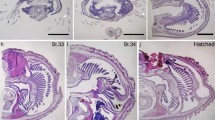Summary
Following observation of conical groups of stiff, but motile cilia on the tentacles of the branchial crown of Sabella pavonina, these were examined with the electron microscope. The bundles consist of about 40 unenclosed “standard” cilia supported by one or two primary sense cells with centrally directed axons of 0.1–0.2 μ diameter. Axons in the distal portions of the branchial crown occur in small bundles surrounded by a basement membrane. More centrally, glial elements appear and the nerves are surrounded by a collagenous sheath. The branchial nerve trunk shows similarities in organisation to other previously investigated annelid central nervous tissue in that the whole nerve is surrounded by a fibrous sheath central to which there is a layer of glial cells with processes penetrating a central neuropile. The 0.1–0.2 μ axons commonly occur in glial-enveloped groups of < 40 whilst other axons of larger and mixed diameter are found together.
Each tentacle has two branchial nerves on the oral side, and each nerve gives rise to two small 75-axon branches running to each pinnule. The branchial nerves fuse to form the branchial nerve trunk running to the supra-oesophageal ganglia.
Sections of the branchial nerves of the branchial crown at progressively more central levels show that the branchial nerve trunk contains enough axons of 0.1–0.2 μ diameter to account for all the sensory cells on the tentacles. This is taken as evidence for the sensory cells having axons terminating within the central nervous system and that there is no peripheral confluence or fusion of these afferent axons.
Similar content being viewed by others
References
Cobb, J. L. S.: The fine structure of the pedicellariae of Echinus esculentus (L.) II. The sensory system. J. Roy. Micr. Soc. 88, 223–233 (1968).
Coggeshall, R. E.: A fine structural analysis of the ventral nerve cord and associated sheath of Lumbricus terrestris. J. comp. Neurol. 125, 393–437 (1965).
Dorsett, D. A., Hyde, R.: The fine structure of the compound sense organ on the cirri of Nereis diversicolor. Z. Zellforsch. 97, 512–527 (1969).
Fox, H. M.: Functions of the tube in Sabellid worms. Nature (Lond.) 141, 163 (1938).
Gray, E. G., Guillery, R. W.: An electron microscopical study of the ventral nerve cord of the leech. Z. Zellforsch. 60, 826–849 (1963).
Horridge, G. A.: Proprioceptors, bristle receptors, efferent sensory impulses, neurofibrils and number of axons in the parapodial nerve of the polychaete Harmothoë. Proc. roy. Soc. B. 157, 199–222 (1963).
—: Some recently discovered underwater vibration receptors in invertebrates. Some contemporary studies in Marine Science, ed. H. Barnes, p. 395–405. London: Allen & Unwin 1966.
Imaizumi, M., Hama, K.: An electron microscope study on the interstitial cells of the gizzard of the love-bird (Uroloncha domestica). Z. Zellforsch. 97, 351–357 (1969).
Knapp, M. F., Mill, P. J.: Chemoreception and efferent sensory impulses in Lumbricus terrestris Linn. Comp. Biochem. Physiol. 25, 523–528 (1968).
Krasne, F. B.: Escape from recurring tactile stimulation in Branchiomma vesiculosum. J. Exp. Biol. 42, 307–322 (1965).
Lawry, J. V.: Structure and function of the parapodial cirri of the Polynoid polychaete Harmothoë. Z. Zellforsch. 82, 345–361 (1967).
—: Efferent sensory impulses in annelids. Comp. Biochem. Physiol. 27, 377–379 (1968)
Mill, P. J., Knapp, M. F.: Efferent sensory impulses and the innervation of tactile receptors in Allolobophora longa Ude and Lumbricus terrestris Linn. Comp. Biochem. Physiol. 23, 263–276 (1967).
—: Neuromuscular junctions in the body wall muscles of the earthworm Lumbricus terrestris Linn. J. Cell Sci. 7, 263–271 (1970).
Nicol, E. A. T.: The feeding mechanism, formation of the tube and physiology of digestion in Sabella pavonina. Trans. roy. Soc. Edinb. 56, 537–598 (1930).
Palade, G. E.: A study of fixation for electron microscopy. J. exp. Med. 95, 285–298 (1952).
Reynolds, E. S.: The use of lead citrate at high pH as an electron-opaque stain in electron microscopy. J. Cell Biol. 17, 208–212 (1963).
Smallwood, W. M.: The peripheral nervous system of the common earthworm Lumbricus terrestris. J. comp. Neurol. 42, 35–55 (1926).
Smith, J. E.: The nervous anatomy of the body segments of nereid polychaetes. Phil. Trans. B 240, 135–196 (1957).
Thomas, J. G.: Pomatoceros, Sabella, and Amphitrite. L.M.B.C. Memoirs XXXIII (1940).
Author information
Authors and Affiliations
Rights and permissions
About this article
Cite this article
Santer, R.M., Laverack, M.S. Sensory innervation of the tentacles of the polychaete, Sabella pavonina . Z. Zellforsch 122, 160–171 (1971). https://doi.org/10.1007/BF00337627
Received:
Issue Date:
DOI: https://doi.org/10.1007/BF00337627




